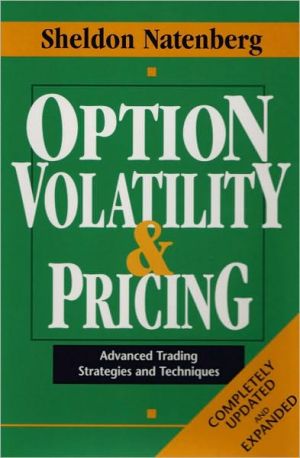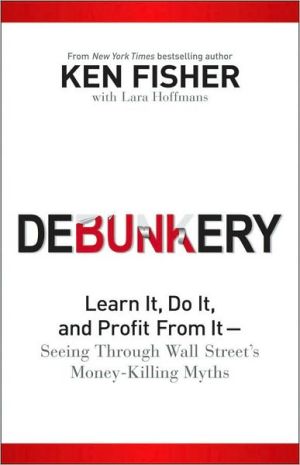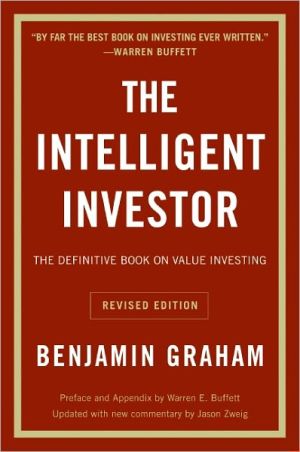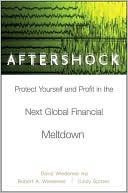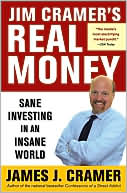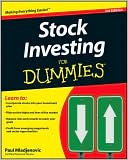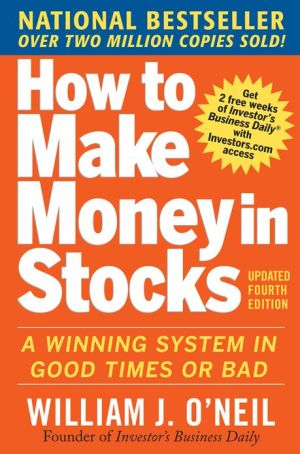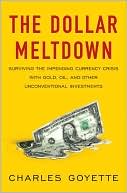Option Volatility & Pricing: Advanced Trading Strategies and Techniques
One of the most widely read books among active option traders around the world, Option Volatility & Pricing has been completely updated to reflect the most current developments and trends in option products and trading strategies.\ Featuring:\ \ Pricing models\ Volatility considerations\ Basic and advanced trading strategies\ Risk management techniques\ And more!\ \ Written in a clear, easy-to-understand fashion, Option Volatility & Pricing points out the key concepts essential to...
Search in google:
One of the most widely read books among active option traders around the world, Option Volatility & Pricing has been completely updated to reflect the most current developments and trends in option products and trading strategies.Featuring: Pricing models Volatility considerations Basic and advanced trading strategies Risk management techniques And more! Written in a clear, easy-to-understand fashion, Option Volatility & Pricing points out the key concepts essential to successful trading. Drawing on his experience as a professional trader, author Sheldon Natenberg examines both the theory and reality of option trading. He presents the foundations of option theory explaining how this theory can be used to identify and exploit trading opportunities. Option Volatility & Pricing teaches you to use a wide variety of trading strategies and shows you how to select the strategy that best fits your view of market conditions and individual risk tolerance.New sections include: Expanded coverage of stock option Strategies for stock index futures and options A broader, more in-depth discussion volatility Analysis of volatility skews Intermarket spreading with options
Option Volatility & Pricing\ Advanced Trading Strategies and Techniques \ \ By Sheldon Natenberg \ McGraw-Hill\ Copyright © 1994 Richard D. Irwin, a Times Mirror Higher Education Group, Inc.\ All right reserved.\ ISBN: 978-0-07-150801-8 \ \ \ Chapter One\ The Language of Options \ Every option market brings together traders and investors with different expectations and goals. Some enter the market with an opinion on which direction prices will move. Some intend to use options to protect existing positions against adverse price movement. Some hope to take advantage of price discrepancies between similar or related products. Some act as middlemen, buying and selling as an accommodation to other market participants and hoping to profit from the difference between the bid and ask price.\ Even though expectations and goals differ, every trader's education must begin with an introduction to the terminology of option trading, and to the rules and regulations which govern trading activity. Without a facility in the language of options, a trader will find it impossible to communicate his desire to buy or sell in the marketplace. Without a clear understanding of the terms of an option contract, and his rights and responsibilities under that contract, a trader cannot hope to make the best use of options, nor will he be prepared for the very real risks of trading.\ CONTRACT SPECIFICATIONS\ Options are of two types. A call option is the right to buy or take a long position in a given asset (typically a security, commodity, index, or futures contract) at a fixed price on or before a specified date. A put option is the right to sell or take a short position in a given asset.\ Note the difference between an option and a futures contract. A futures contract requires delivery at a fixed price. The buyer and seller of a futures contract both have obligations which they must meet. The seller must make delivery and the buyer must take delivery of the asset. The buyer of an option, however, has a choice. He can choose to take delivery (a call) or make delivery (a put). If the buyer of an option chooses to either make or take delivery, the seller of the option is obligated to take the other side. In option trading all rights lie with the buyer and all obligations with the seller.\ The asset to be bought or sold under the terms of the option is the underlying asset or, more simply, the underlying. The exercise price, or strike price, is the price at which the underlying will be delivered should the holder of an option choose to exercise his right to buy or sell. The date after which the option may no longer be exercised is the expiration date.\ If an option is purchased directly from a bank or other dealer, the quantity of the underlying to be delivered, the exercise price, and the expiration date can all be tailored to meet the buyer's individual requirements. If the option is purchased on an exchange, the quantity of the underlying to be delivered, as well as the exercise price and expiration date, are predetermined by the exchange.\ As an example of an exchange traded option, the buyer of a crude oil October 21 call on the New York Mercantile Exchange has the right to take a long position in one October crude oil futures contract for 1,000 barrels of crude oil (the underlying), at a price of $21 per barrel (the exercise price), on or before October expiration (the expiration date). The buyer of a General Electric March 80 put on the Chicago Board Options Exchange has the right to take a short position in 100 shares of General Electric stock (the underlying) at a price of $80 per share (the exercise price), on or before March expiration (the expiration date).\ Since stock has no expiration date, the underlying asset for a stock option is simply some number of shares in the underlying stock. In the case of futures options, however, the situation can be somewhat confusing, since a futures contract has a limited life span. The underlying asset for an option on a futures contract is usually the futures month identical to the expiration month of the option. The underlying asset for a crude oil October 21 call on the NYMEX is one October crude oil futures contract. The underlying asset for a Treasury Bond June 96 put on the Chicago Board of Trade is one June Treasury Bond futures contract.\ Some futures exchanges also list serial options, whereby options with different expiration dates have identical underlying futures contracts. When there is no futures contract with the same expiration month as the option, the underlying contract for that option is the nearest futures contract after the expiration of the option. For example, the underlying for a December Deutschemark option on the Chicago Mercantile Exchange is one December Deutschemark futures contract. With no October or November futures contract available, the underlying for an October or November Deutschemark option is also one December futures contract. December is the nearest futures month after the expiration of October and November options.\ Expiration dates for exchange traded contracts are not uniform, but are set by each individual exchange. The expiration date for stock options in the United States is usually the third Saturday after the third Friday of the expiration month. For options on futures contracts, however, the expiration need not coincide with the delivery month specified in the option contract. In some cases the exact expiration date for a futures option can predate the delivery month of the underlying futures contract by several weeks. A crude oil option on the NYMEX will typically expire the first Saturday of the preceding month, so that an October option will actually expire the first Saturday in September.\ EXERCISE AND ASSIGNMENT\ A trader who owns a call or a put option has the right to exercise that option prior to its expiration date, thereby converting the option into a long underlying position, in the case of a call, or a short underlying position, in the case of a put. A trader who exercises a crude oil October 21 call has chosen to take a long position in one October crude oil futures contract at $21 per barrel. A trader who exercises a GE March 80 put has chosen to take a short position in 100 shares of GE stock at $80 per share. Once an option is exercised it ceases to exist, just as if it had been allowed to expire unexercised.\ A trader who intends to exercise an option must submit an exercise notice to either the seller of the option, if purchased from a dealer, or to the guarantor of the option, if purchased on an exchange. When a valid exercise notice is submitted, the seller of the option is assigned. Depending on the type of option, he will be required to take a long or short position in the underlying contract at the specified exercise price.\ In addition to its underlying contract, exercise price, expiration date, and type, an option is further identified by the conditions of exercise. An option is either American, whereby the holder can exercise the option at any time prior to expiration, or European, whereby the holder can exercise the option only on expiration day. The great majority of exchange traded options throughout the world are American options, carrying with them the right of early exercise. Indeed, all U.S. exchange traded stock and futures options are American.\ As in any competitive market, an option's price, or premium, is determined by supply and demand. Buyers and sellers make competitive bids and offers in the marketplace. When a bid and offer coincide, a trade is made. The premium paid for an option can be separated into two components, the intrinsic value and the time value. An option's intrinsic value is the amount which would be credited to the option holder's account if he were to exercise the option and close out the position against the underlying contract at the current market price. For example, with gold trading at $435 per ounce, the intrinsic value of a $400 call is $35. By exercising his option, the holder of the $400 call can buy gold at $400 per ounce. If he sells gold at the market price of $435 per ounce, $35 per ounce will be credited to his account. With a certain stock trading at $62, the intrinsic value of a $70 put is $8. By exercising his option, the holder of the put can sell the stock at $70 per share. If he then buys the stock back at the market price of $62, he will show a total credit of $8.\ A call will only have intrinsic value if its exercise price is less than the current market price of the underlying contract. A put will only have intrinsic value if its exercise price is greater than the current market price of the underlying contract. The amount of intrinsic value is the amount by which the call's exercise price is less than the current underlying price, or the amount by which the put's exercise price is greater than the current underlying price. No option can have an intrinsic value less than zero.\ Usually an option's price in the marketplace will be greater than its intrinsic value. The additional amount of premium beyond the intrinsic value which traders are willing to pay for an option is the time value, sometimes also referred to as the option's time premium or extrinsic value. As we shall see, market participants are willing to pay this additional amount because of the protective characteristics afforded by an option over an outright long or short position in the underlying contract.\ An option's premium is always composed of precisely its intrinsic value and its time value. If a $400 gold call is trading at $50 with gold at $435 per ounce, the time value of the call must be $15, since the intrinsic value is $35. The two components must add up to the option's total premium of $50. If a $70 put on a stock is trading for $9 with the stock at $62, the time value of the put must be $1, since the intrinsic value is $8. The intrinsic value and the time value must add up to the option's premium of $9.\ Even though an option's premium is always composed of its intrinsic value and its time value, it is possible for one or both of these components to be zero. If the option has no intrinsic value, its price in the marketplace will consist solely of time value. If the option has no time value, its price will consist solely of intrinsic value. In the latter case, we say that the option is trading at parity.\ While an option's intrinsic value can never be less than zero, it is possible for an option, if it is European, to have a negative time value. (More about this when we look at early exercise in Chapter 12.) When this happens the option can trade for less than parity. Usually, however, an option's premium will reflect some non-negative amount of intrinsic and time value.\ Any option which has a positive intrinsic value is said to be in-the-money by the amount of the intrinsic value. With a stock at $44, a $40 call is $4 in-the-money. With Deutschemarks at 57.75, a 59 put is 1.25 in-the-money. An option which has no intrinsic value is said to be out-of-the-money. The price of an out-of-the-money option consists solely of time value. In order to be in-the-money, a call (put) must have an exercise price lower (higher) than the current price of the underlying contract. Note that if a call is in-the-money, a put with the same exercise price and underlying contract must be out-of-the-money. Conversely, if the put is in-the-money, a call with the same exercise price must be out-of-the-money.\ Finally, an option whose exercise price is identical to the current price of the underlying contract is said to be at-the-money. Technically, such an option is also out-of-the-money since it has no intrinsic value. We make the distinction between an at-the-money and out-of-the-money option because an at-the-money option has the greatest amount of time premium and is usually traded very actively.\ If we want to be very precise, the exercise price of an option must be identical to the current price of the underlying contract for the option to be at-the-money. However, for exchange-traded options, the term is commonly applied to the call and put whose exercise price is closest to the current price of the underlying contract. With a stock at $74 and $5 between exercise prices ($65, $70, $75, $80, etc.), the $75 call and the $75 put would be considered the at-the-money options. These are the call and put options with exercise prices closest to the current price of the underlying contract.\ MARKET INTEGRITY\ An important consideration for every market participant is the integrity of the market. No trader will want to trade in a market where there is a chance that the opposing trader will default on a contract. If a trader purchases an option, he wants to be certain that the seller will fulfill the terms of the contract if the option is exercised.\ In order to guarantee that the integrity of the market will be maintained, each options exchange has established a progression of responsibility for the fulfillment of the terms of an option. The primary responsibility falls to the individual trader. If the seller of an option is assigned, he must be prepared to take the required long or short position in the underlying contract at the specified exercise price. In practical terms, this means a trader must have access to capital at least equal to the option's intrinsic value.\ If an individual trader is unable to fulfill the terms of the contract, the responsibility falls to the trader's clearing firm. A clearing firm is a member firm of the exchange which processes trades made by an individual, and which agrees to fulfill any financial obligation arising from those trades. No individual may trade on an exchange without first becoming associated with a clearing firm.\ If the clearing firm cannot fulfill the terms of the contract, the final responsibility rests with the clearing house. Each exchange has established, or has become a member of, a clearing house which guarantees the integrity of all trades. Once an option trade has been made, the connection between the buyer and seller is severed, with the clearing house assuming the role of buyer from every seller, and seller to every buyer. If there were no central clearing house, the buyer of an option would be totally dependent on the good faith of the seller or the seller's clearing firm to fulfill the terms of the option in the event of exercise. Because the clearing house guarantees every trade, all buyers can be certain there will be an opposing party prepared to make or take delivery if an option is exercised. The clearing process is shown in Figure 1-8.\ This system of guarantees has proven effective in ensuring the integrity of options exchanges. While individual traders and clearing firms occasionally fail, a clearing house has never failed in the United States.\ MARGIN REQUIREMENTS\ When a trader makes an opening trade on an exchange, the exchange may require the trader to deposit with the clearing house some amount of margin, or good faith capital. Such deposits ensure that if the market moves adversely, the trader will still be able to fulfill any future financial obligations resulting from the trade.\ In lieu of cash, margin requirements may often be met by depositing government treasury instruments or, less commonly, commercial securities. Clearing firms collect these margin requirements from their traders and forward the funds to the clearing house. In theory, margin deposits at the clearing house still belong to the individual trader and, as such, any interest or dividends accruing to the margin deposit also belongs to the trader. Some clearing firms, however, do not return this interest to the trader, claiming that it is part of the fee paid by the trader for the clearing services of the member firm. This can occasionally become a sensitive point between trader and clearing firm, and should be settled before an individual begins to trade.\ Margin requirements for both options and underlying contracts are set by the clearing house, using as guidelines the current value of the position as well as the potential risk. While an underlying position, particularly if it is a futures contract, usually has a fixed margin requirement, the margin for an option position can change over time since the margin for an option often depends on the amount by which it is in- or out-of-the-money. Positions consisting of a combination of options, or options and underlying instruments, may have reduced margin requirements because the risk to one contract may be partially offset by the value of another contract. Additionally, traders who are exchange members may receive professional consideration in the form of reduced margin requirements. Every trader should become familiar with the margin requirements for the market in which he is trading. Doing so will ensure that he has sufficient capital to initiate and hold positions as long as he deems necessary.\ (Continues...)\ \ \ \ \ Excerpted from Option Volatility & Pricing by Sheldon Natenberg Copyright © 1994 by Richard D. Irwin, a Times Mirror Higher Education Group, Inc.. Excerpted by permission of McGraw-Hill. All rights reserved. No part of this excerpt may be reproduced or reprinted without permission in writing from the publisher.\ Excerpts are provided by Dial-A-Book Inc. solely for the personal use of visitors to this web site. \ \
Preface to the First EditionPreface to the Second Edition1The Language of Options12Elementary Strategies133Introduction to Theoretical Pricing Models354Volatility515Using an Option's Theoretical Value816Option Values and Changing Market Conditions957Introduction to Spreading1278Volatility Spreads1379Risk Considerations17310Bull and Bear Spreads19911Option Arbitrage21312Early Exercise of American Options24113Hedging with Options25714Volatility Revisited27315Stock Index Futures and Options30116Intermarket Spreading33117Position Analysis35318Models and the Real World385Appendix A A Glossary of Option and Related Terminology419Appendix B The Mathematics of Option Pricing431Appendix C Characteristics of Volatility Spreads449Appendix D What's the Right Strategy?451Appendix E Synthetic and Arbitrage Relationships453Appendix F Recommended Reading457Index463
